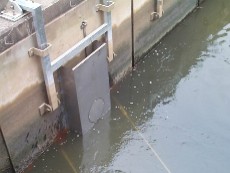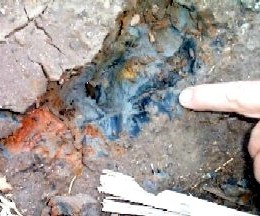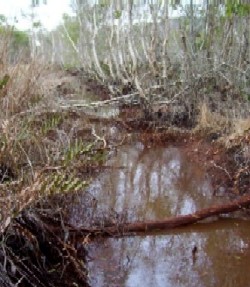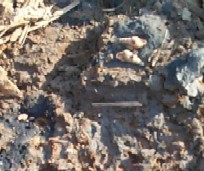|

| | 
Links found on this page -
acid cycle , acid discharge ,
acid run off , coastal regions ,
Calibrated Flood Gate Valve ,
CRAB , eco-system ,
environmental ,
iron monosulfide ,
sulfidic muds & soils

Acid Sulphate Soils
Actively
Treating the Acid Sulfate Soils problem.
 |
 A hand spray
nozzle attached to a quadbike for access into difficult areas or along drains. A hand spray
nozzle attached to a quadbike for access into difficult areas or along drains.
|
 |
Acid
Sulfate Soils can be treated through a chemical process using mainly lime
products. |
 |
Acid SolutionsPty
Ltd have manufactured the
CRAB - a Calibrated Reagent Applicating
Blender that can return the pH to normal levels. |
 |
 Floodgate
manipulation using the Calibrated Flood
Gate Valve is another device that allows a continual flow of sea
water into and out of canal and river systems, maintaining a constant flow of
salt water and allowing juvenile fish species to breed whilst protecting low
lying tidal flood prone areas. Floodgate
manipulation using the Calibrated Flood
Gate Valve is another device that allows a continual flow of sea
water into and out of canal and river systems, maintaining a constant flow of
salt water and allowing juvenile fish species to breed whilst protecting low
lying tidal flood prone areas. |

Acid Sulfate Soils, what
are they?
Acid Sulphate Soils - how
are they formed?.
 |
The Acid Sulfate Soils that are of the most concern
were formed when the coastal strip was underwater. Over the past 10,000 years the
acid cycle has been naturally forming and the Acid Sulfate Soils involved
are inactive unless disturbed. |
 |
Acid Sulphate Soils form when sea water, containing
sulfides + land sediments, containing iron oxides + organic matter mix under
anaerobic conditions forming iron sulfides (FeS). |
 |
Even today Acid Sulfate Soils occur
naturally in tidal areas and back swamps and appear to be occurring inland due
to inland salinity. |
Potential Acid Sulphate
Soils or (PASS).
 |
These iron sulfides remain stable in the waterlogged, anaerobic, soils and are
termed Potential Acid Sulphate Soils or (PASS). These PASS
are usually dark grey in colour while spongy & soft to touch. The
pH of PASS is normally close to neutral, pH 6.5-7.5. |
 |
The reaction starts when the Acid Sulfate Soils oxidize, ie, comes in
contact with the air through development, drainage, drought cracking and
natural disturbance. |
 |
The naturally producing acid from the
iron sulfide layers is usually neutralized by the sea water through the natural tidal
movements. Through the event of development, more potential acid
sulfate soils (PASS) are oxidized and subsequent acid production is greater
than can be dealt with in the natural acid neutralizing cycle. The tidal watercourse
are not able to
neutralize the large amount of acid in the water resulting in detrimental
effects to the health of marine life ie, fish kills, and other organisms
reliant on life in the watercourses. |
Actual Acid Sulfate Soils
or (AASS).
 |
 |
 |
Note:
The black iron monosulfide. The grey Potential Acid Sulfate Soil and the
oxidised region from drying and cracking. You can also see the dry
cracked appearance of the drain bed surface. |
 |
In many cases PASS and AASS are right next to each
as seen in the photo above. |
 |
These soils contain oxidised iron sulfides producing
sulfuric acid and have a pH of generally less than 4. As the name
suggests they are active and creating sulfuric acid. Soils may even contain jarosite which is yellow in colour and a visual factor that
further oxidation is in
process. |
 |
When Potential Acid Sulphate Soils
are exposed, oxidisation products take the form of red iron stains and extreme
pH 1.5 may be encountered. |
Acid Sulfate Soils -
Development & Construction.
 |
The acid run off
problem starts when areas containing Potential Acid Sulphate Soils became
disturbed resulting in oxidation. |
 |
As Acid Sulfate Soils mostly occur in
coastal regions. Population demand, along
with increased development have seen the need for utilising seemingly 'wasted
wet lands'. Through the draining of flood plains, clearing of wetlands,
extending areas for future developments and the provision for infrastructure
we have seen the degradation of these potential Acid Sulphate Soil areas where
they are now being exposed and consequently oxidizing and forming sulfuric acid.
|
 |
Coastal constructions
such as concrete bridge pylons or drainage head works are often affected by
low pH water. The acids reacting with alkaline products that are used to
produce concrete. |
 |
During the rain periods
the large quantities of acid discharge travel through the soil,
acidifying the soil water, groundwater and eventually the surface water.
This is made more significant particularly when there has been an extended dry
period. The surface layer dries and cracks allowing oxidation. |
 |
 Highly
acidic environmentally degraded discharge drain. Highly
acidic environmentally degraded discharge drain.
|
Sulfuric Acid
(H²SO4) and other
Chemicals.
 |
One of the most concerning problems with Acid
Sulfate Soils is when oxidation occurs and sulfuric acid is produced which can 'strip' & dissolve potential heavy metals out of the soils. These chemicals could be
iron, aluminum, manganese and even heavier metals such as cadmium and arsenic.
This effects the delicate eco-system in these areas
making it difficult for plants and animals to continue surviving. |
 |
At times there can be so much
sulfuric acid present that plants will not grow and the land is bare with a
scalded appearance. |
 |
It has been shown that highly acidic water
causes corrosion of steel and concrete structures such as bridges,
fencing, pipes and floodgates. |
Sulfuric Acid
(H²SO4) and the Environment.
 |
What starts & or continues is a complex chemical
reaction that spreads into nearby environmental areas. Making it hard for crops to access necessary
macro N.P.K. (Nitrogen, Phosphorous, Potassium) nutrients normally found in soils to produce a viable yield.
|
 |
In acidic conditions macro nutrients,
N.P.K., are not available while low pH soluble micro nutrients like aluminium
and iron are available. |
 |
 Highly
oxidised site due to Feral pig damage. Highly
oxidised site due to Feral pig damage.
|
 |
Naturally forming animal fodder may decline and in
its wake may grow more salt tolerant unpalatable plants. Any farm animals relying on
this pasture may ingest toxic levels of metals from these plants.
|
 |
The farms water supply may be affected by higher
levels of chemicals. |
 |
Noticeable effects of increased acidity
is a detrimental decline in essential marine life. |
 |
 |
 |
One of the
most significant indications of acidic water is the decrease in water quality
resulting in fish kills, including oysters and crustaceans
(see Photo). |
 |
 |
 |
Juvenile
mud crabs hiding in the damp un-oxidised iron mono sulfide. |
 |
Long term effects may result in the decline or
cessation of fishing or aquaculture industries relying on the breeding of fish
in the local waterways. |

|
